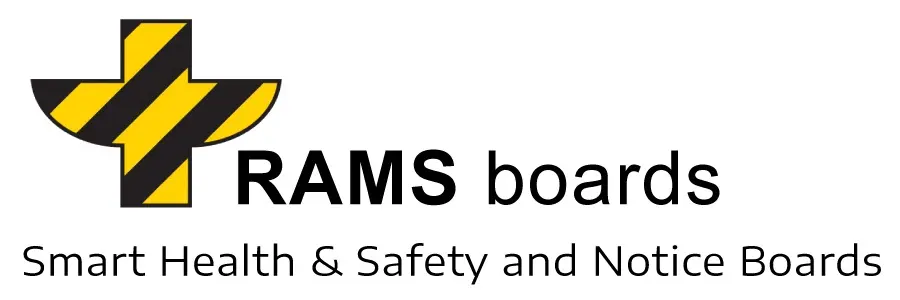In today’s ever-evolving work environments, ensuring the safety and well-being of employees has never been more critical. One standout solution gaining traction is the use of free-standing health and safety information points. These portable and adaptable units are designed to display essential health and safety information across diverse settings—whether in bustling construction zones or dynamic office spaces. Their flexibility is particularly valuable in areas where wall space is limited or where double-sided displays can attract attention from multiple directions.
Think of these information points as central hubs for safety communication. They provide employees with quick and easy access to key guidelines, timely updates, and urgent alerts. By strategically placing them in high-traffic areas, organizations can effectively disseminate critical safety messages. This approach not only keeps employees informed but also increases their awareness of potential hazards. The result is a proactive strategy that enhances workplace safety while fostering a culture of vigilance and shared responsibility.
As the focus on health and safety continues to grow, these information points are becoming indispensable. They offer a practical and innovative solution to meet compliance requirements while cultivating a safer and more informed workforce. Could these modern tools be the transformative solution that elevates workplace safety and sets a new standard for employee care?
Understanding Free-Standing Health & Safety Information Points
Workplace safety is a constantly evolving challenge, shaped by new standards and emerging risks. Staying ahead of these changes is no small feat. Enter free-standing health and safety information points—versatile tools that go beyond merely displaying safety messages. They ensure these messages are impossible to overlook. Whether placed in a bustling office or a high-risk construction site, these information points are essential for maintaining health and safety protocols.
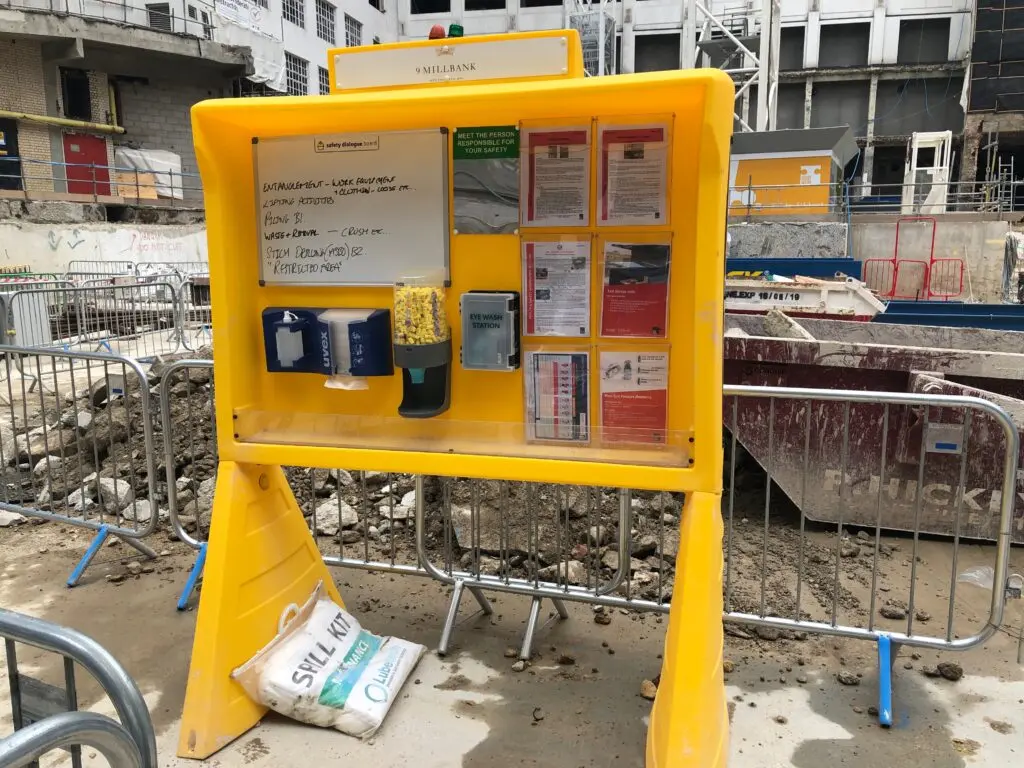
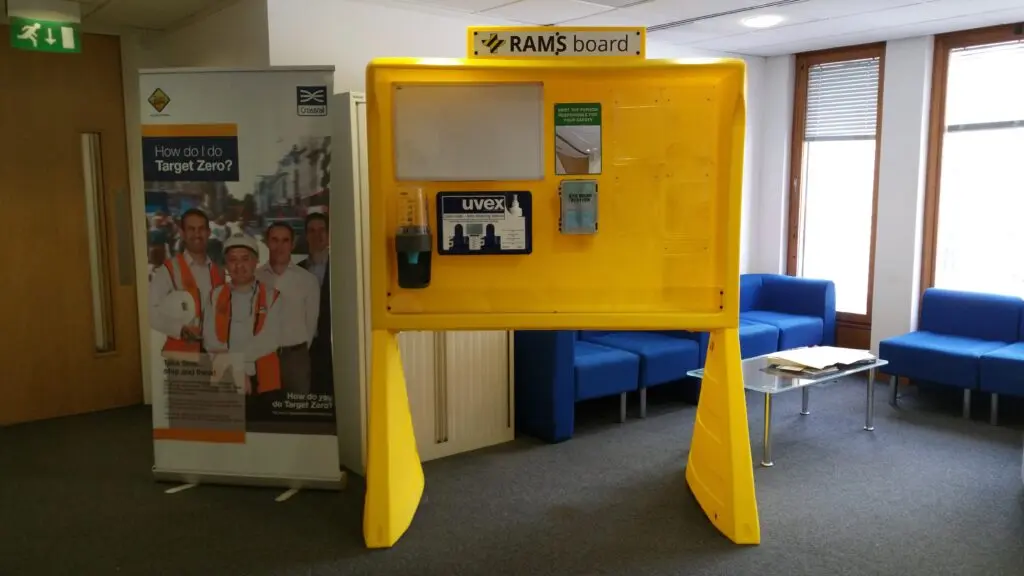
What makes them unique? Their portability and adaptability. These units can be positioned exactly where they are needed most, especially in areas with limited wall space or where a double-sided display can maximize visibility. This flexibility allows organizations to respond to changing needs while keeping critical safety information easily accessible. More than just compliance tools, these information points foster a culture of safety and awareness, which is vital in today’s fast-paced work environments.
What are Free-Standing Health & Safety Information Points?
At their core, free-standing health and safety information points are designed to make safety messages impossible to miss. This is crucial for keeping employees, visitors, and contractors informed about safety protocols and potential hazards. By placing health and safety signage front and center, these units help organizations meet regulatory requirements while creating a safer environment for everyone.
But these tools are far more than static signs. They are dynamic, customizable, and tailored to the specific needs of any workplace. From emergency procedures and PPE (Personal Protective Equipment) guidelines to site-specific safety instructions, these units ensure that the most critical information is always prominently displayed. This adaptability not only enhances compliance but also empowers individuals to take ownership of their safety and look out for their colleagues.
Key benefits of using Free-Standing Information Points
Why should free-standing information points be a priority for your organization? Here are the key benefits:
- Unmatched Visibility: Placed in high-traffic areas, these units ensure safety messages are seen by everyone, significantly reducing the risk of accidents and mishaps.
- Flexibility: Unlike fixed wall-mounted signs, these units can be relocated and adjusted as workplace layouts or operations change. This is especially valuable in dynamic environments like construction sites, where conditions can shift rapidly.
- Commitment to Safety: By keeping safety at the forefront, these units demonstrate your organization’s dedication to fostering a secure and well-informed workplace.
Types of free-standing Health & Safety Information Points
Workplace safety can be complex, but understanding the various types of free-standing health and safety information points can make a significant difference. These tools are designed to address specific safety needs, whether you’re managing a bustling construction site or a quiet office. Think of them as the unsung heroes of workplace safety—keeping everyone informed, compliant, and, most importantly, safe.
Some of the most popular options include:
- A-frame site boards: Known for their stability and dual-sided displays, ideal for areas requiring visibility from multiple angles.
- Health and safety at work information points: Comprehensive hubs for legislative guidance, covering topics like COSHH compliance and PPE requirements.
- Customizable free-standing boards: Allow businesses to tailor safety messages and incorporate branding.
- First aid points with near-miss reporting: Combine first aid essentials with tools to manage and analyze incidents proactively.
- Daily activity boards: Streamline operations by tracking daily tasks and schedules.
- Sanitization points: Essential for maintaining hygiene in high-traffic areas.
- Construction-specific boards: Address site-specific needs like PPE guidelines and emergency procedures.
A-frame site boards: stability and dual-sided display
A-frame site boards are a top choice for those needing something sturdy and versatile. Built with a stable A-frame structure, these boards stand firm even in high-traffic environments like construction sites or open-plan offices. Their dual-sided design allows for different safety messages on each side, making them both practical and efficient.
Whether you’re showcasing emergency evacuation routes or PPE requirements, these boards ensure critical information is always visible. They’re like a dependable colleague—always there when you need them, enhancing workplace safety and awareness.
Health & Safety at Work Information Points: legislative guidance
Health & Safety at Work Information Points serve as encyclopedias of workplace safety. Packed with essential legislative guidance, they cover everything from COSHH compliance to manual handling and PPE requirements. These units ensure everyone is aligned with safety regulations.
By displaying clear, accessible information, these points foster a culture of accountability and safety. They simplify complex safety rules, transforming your workplace into a compliant and genuinely secure environment.
Customizable free-standing boards: tailored safety solutions
Customizable free-standing boards offer a blank canvas for your safety strategy. Whether you want to incorporate your company’s branding or craft specific safety messages, these boards allow you to design solutions that align with your unique needs.
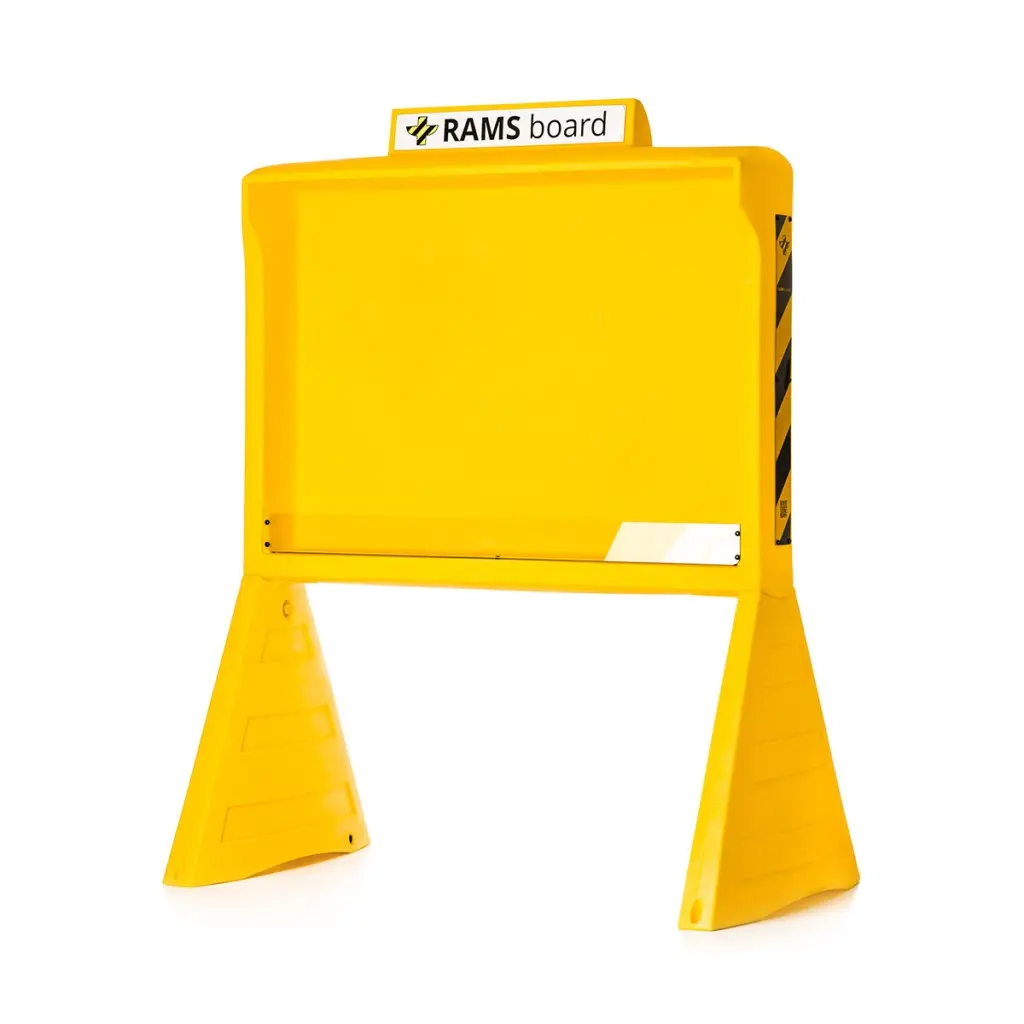
By personalizing these boards, you’re not just sharing information—you’re demonstrating that safety is a top priority. Employees feel valued, and you create a safer, more compliant workplace. These boards also reinforce your company’s commitment to fostering a secure environment.
First aid points with near miss reporting: combining safety and incident management
First aid points with near-miss reporting are a game-changer. They merge the essentials—like first aid supplies—with tools to document and analyze near-miss incidents. It’s like having a safety toolkit and a predictive tool rolled into one.
These points encourage a proactive approach to safety. By identifying risks before they escalate into accidents, you’re not just reacting—you’re preventing. This fosters a culture of continuous improvement, where employees are prepared for emergencies and actively contribute to a safer workplace.
Free-standing daily activity boards: organizational tools for workplaces
Free-standing daily activity boards are indispensable for workplace organization. With dry-wipe surfaces for easy updates, these boards simplify tracking daily tasks, schedules, and safety protocols. They’re like a personal assistant for your workplace, keeping everyone aligned.
By centralizing daily activity tracking, these boards enhance communication and coordination within teams. The result? A more organized, productive, and safer workplace. When everyone knows what’s happening and what’s expected, staying aligned with goals and safety standards becomes second nature.
Free-standing sanitisation points: hygiene solutions for high-traffic areas
Free-standing sanitisation points are essential in today’s health-conscious world. Equipped with items like hand sanitizers and wipes, these units help maintain cleanliness, creating a safer environment for everyone.
They’re particularly valuable in high-traffic areas like healthcare facilities and public spaces, where hygiene is paramount. By promoting regular hand hygiene, these points reduce the risk of illness and serve as a constant reminder of the importance of cleanliness. In essence, they’re a simple yet powerful way to prioritize health and well-being in the workplace.
Free-standing construction Health & Safety Points: site-specific safety
Free-standing construction health and safety points are tailored to the unique demands of construction sites. These units focus on site-specific measures like PPE requirements, emergency procedures, and safety rules, ensuring everyone understands their responsibilities.
Often featuring PPE safety signs, these boards emphasize the importance of protective gear and compliance with safety standards. They’re not just about ticking boxes—they’re about fostering a safety-first culture that adapts to the dynamic nature of construction work. Could these boards be the key to navigating the complexities of modern construction sites? Absolutely.
RAMS Boards: an innovative solution for health and safety safety at work
RAMS whiteboards are an advanced solution that not only has the features of typical free-standing whiteboards, but offers even more possibilities. They can be easily moved and positioned anywhere, both indoors and outdoors, ensuring that they are always in the most convenient location. Equipped with anchoring points and meeting wind load standards, they can withstand harsh weather conditions, making them a reliable solution even in the most demanding locations.
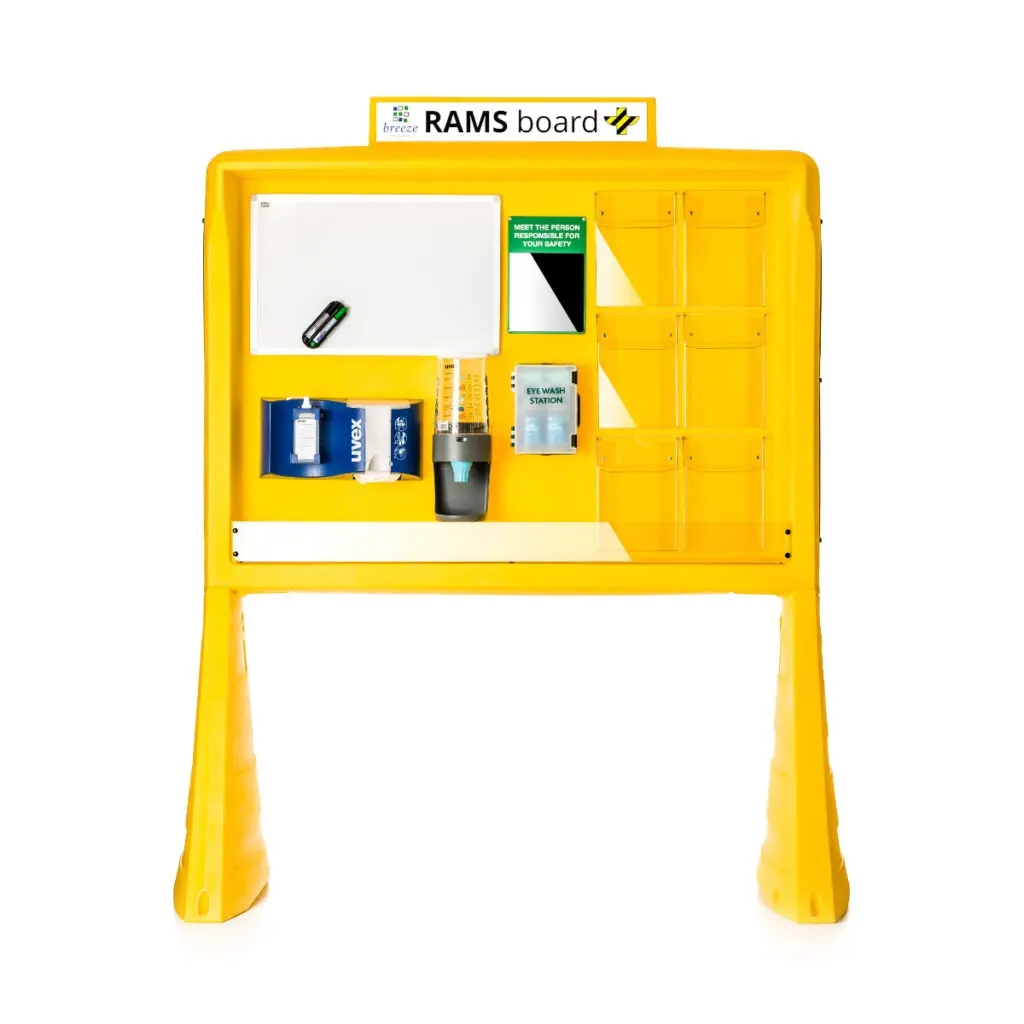
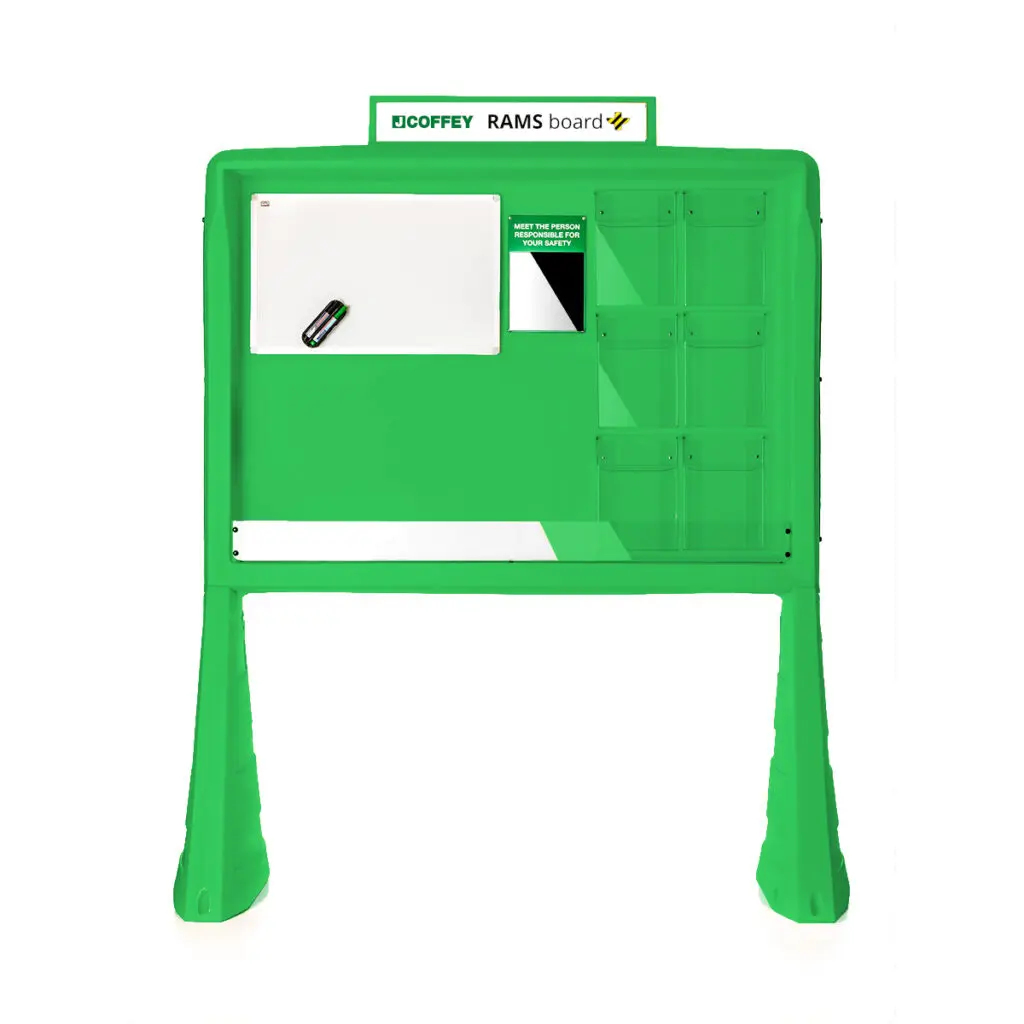
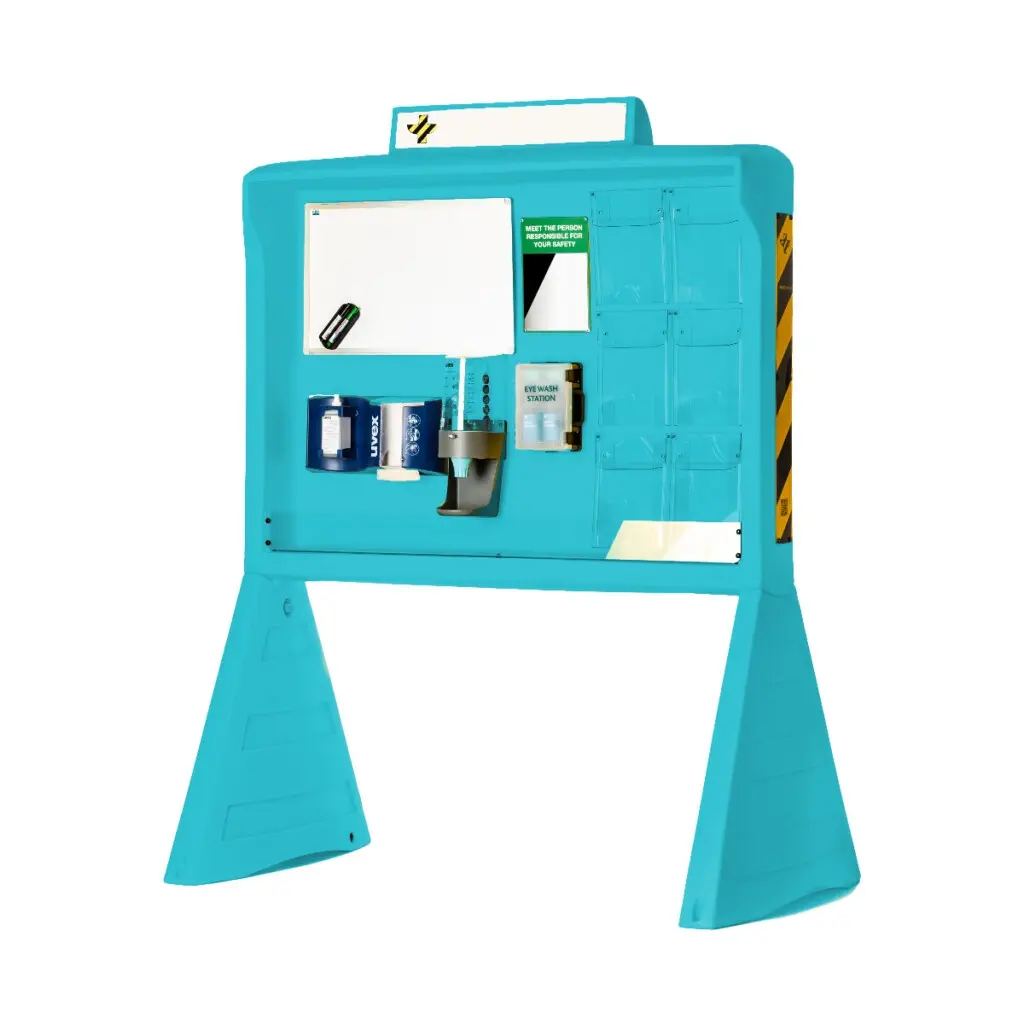
Manufactured from high-density polyethylene, RAMS signs are extremely durable and UV resistant, guaranteeing their aesthetic appearance and functionality for a long time. They are also distinguished by a wide colour palette, allowing them to be tailored to the specific needs and requirements of the organisation. The ability to personalise colours is particularly useful when different categories of information need to be marked or key messages highlighted.
RAMS boards not only function perfectly as health and safety information points, but also surpass them in terms of versatility and functionality. They can be used to display emergency procedures, personal protective equipment (PPE) rules, as well as detailed instructions related to specific tasks in a particular area. Their aesthetically pleasing design and reusability support a safety culture in the workplace, while highlighting the professionalism of the organisation.
Enhancing workplace safety with Free-Standing Information Points
Workplace safety is more than just a legal requirement—it’s the backbone of a productive and thriving work environment. Enter free-standing information points, which serve as dynamic safety ambassadors. These versatile tools provide a highly visible and accessible way to communicate critical safety procedures. By offering immediate access to essential safety details, they empower employees to take control of risk management and foster a proactive, safety-first culture.
Supporting Workplace Risk Assessments with safety displays
Effective workplace risk assessments are essential for managing hazards. Free-standing health and safety information points play a crucial role in this process by prominently displaying key safety protocols. This ensures employees are consistently aware of potential risks and the steps required to mitigate them. The constant visibility of these tools promotes a safety-conscious mindset and encourages individuals to take ownership of their personal well-being.
- Daily Reminders: These information points act as ever-present safety mentors, reinforcing workplace rules and reducing the likelihood of accidents.
- Seamless Integration: When integrated into the work environment, they make safety information accessible and engaging.
- Enhanced Vigilance: Employees remain informed and alert, fostering a culture of safety.
Integrating near-miss reporting tools for incident prevention
Preventing workplace incidents often depends on identifying risks early. Near-miss reporting tools, embedded within free-standing health and safety information points, simplify the process of documenting and analyzing near-miss events. These tools provide invaluable insights into potential hazards and areas requiring attention, enabling organizations to proactively address risks and implement measures to prevent future accidents.
- Data-Driven Prevention: Insights from near-miss reports help organizations identify and mitigate risks effectively.
- Fostering a Safety Culture: Encouraging employees to report near-misses without fear of blame nurtures a culture of shared responsibility.
- Continuous Improvement: Open communication enhances incident prevention and demonstrates the organization’s commitment to safety.
Promoting PPE usage with safety signs and posters
In hazardous work environments, personal protective equipment (PPE) is not optional—it’s essential. PPE safety signs and posters, integrated into free-standing health and safety points, serve as constant visual reminders. These tools ensure employees are always equipped to navigate hazardous conditions safely.
- Clear Guidelines: PPE signs outline requirements, helping organizations comply with Health and Safety Legislation.
- Strategic Placement: Positioned in high-risk zones, these signs keep safety messages front and center.
- Reinforcing Safety Protocols: They emphasize the importance of PPE and encourage adherence to safety measures.
Ensuring compliance with safety signage standards
Maintaining a safe workplace requires adherence to established safety signage compliance standards. Free-standing health and safety information points are designed to meet rigorous standards, such as BS EN ISO 7010, ensuring all safety signage is clear, consistent, and easy to interpret. This uniformity is especially critical in high-pressure or emergency scenarios.
- Dependable Communication: Aligning safety signage with recognized standards establishes a reliable system employees can trust.
- Regulatory Compliance: Meeting compliance standards demonstrates the organization’s commitment to Office Health and Safety.
- Future-Ready: These information points make it simple for organizations to adapt to evolving safety regulations, safeguarding their workforce and maintaining compliance.
Complementary tools and accessories
Workplace safety goes beyond policies—it’s about equipping the environment with the right tools to support them. The right accessories not only enhance the functionality of free-standing health and safety information points but also strengthen the overall safety framework. With these tools in place, organizations can proactively address risks and foster a safer, more secure environment for everyone.
Health and Safety Posters: visual communication of safety messages
Health and safety posters are essential for delivering critical safety messages in a clear and engaging manner. These visual aids simplify complex information—such as safety protocols and legal obligations—ensuring employees remain aware of the precautions they need to follow. Strategically placing these posters near free-standing information points amplifies their impact, reinforcing key messages and encouraging adherence to safety policies.
- Attention-Grabbing Design: These posters are designed to capture attention and communicate effectively, whether it’s a reminder to wear protective equipment or a step-by-step guide for emergency procedures.
- Reinforcing Safety Culture: By combining these posters with other safety measures, organizations can elevate workplace awareness and embed safety into daily routines.
- Strategic Placement: Positioning posters near high-traffic areas ensures maximum visibility and impact.
Imagine the synergy created by integrating these posters with other safety tools—together, they can cultivate a safety-first culture and make safety an integral part of daily operations.
COSHH Compliance information and manual handling guidelines
Adhering to safety regulations is fundamental to maintaining a secure workplace, and COSHH compliance information plays a pivotal role in this effort. These guidelines provide comprehensive instructions for managing hazardous substances, helping organizations mitigate risks associated with chemical exposure. Including COSHH details at health and safety information points equips employees with the knowledge they need to handle dangerous materials responsibly.
- Comprehensive Hazard Management: COSHH guidelines outline safe practices for handling hazardous substances, reducing risks of chemical exposure.
- Accessible Information: Placing COSHH details at information points ensures employees can easily access critical safety instructions.
Similarly, manual handling guidelines are crucial for promoting safe lifting practices and reducing the risk of physical injuries. By providing straightforward advice on proper lifting techniques, organizations can significantly lower the incidence of musculoskeletal issues.
- Injury Prevention: Clear instructions on lifting techniques help minimize physical strain and prevent injuries.
- Consistent Application: Innovative approaches, such as training sessions or visual demonstrations, can ensure these guidelines are understood and consistently applied.
By integrating COSHH compliance information and manual handling guidelines into workplace safety strategies, organizations can create an environment where safety and compliance are seamlessly embedded into daily operations.
Fire extinguisher bundle deals and directional exit signs
Fire safety is non-negotiable, and having the right equipment is essential for meeting safety legislation. Opting for fire extinguisher bundle deals is a practical choice, offering multiple extinguishers and related accessories to prepare workplaces for fire emergencies. These bundles complement free-standing health and safety information points, forming a comprehensive safety strategy.
- Comprehensive Fire Safety: Bundle deals provide workplaces with multiple extinguishers and accessories, ensuring readiness for emergencies.
- Cost-Effective Solutions: Bundles offer a practical and economical way to meet fire safety requirements.
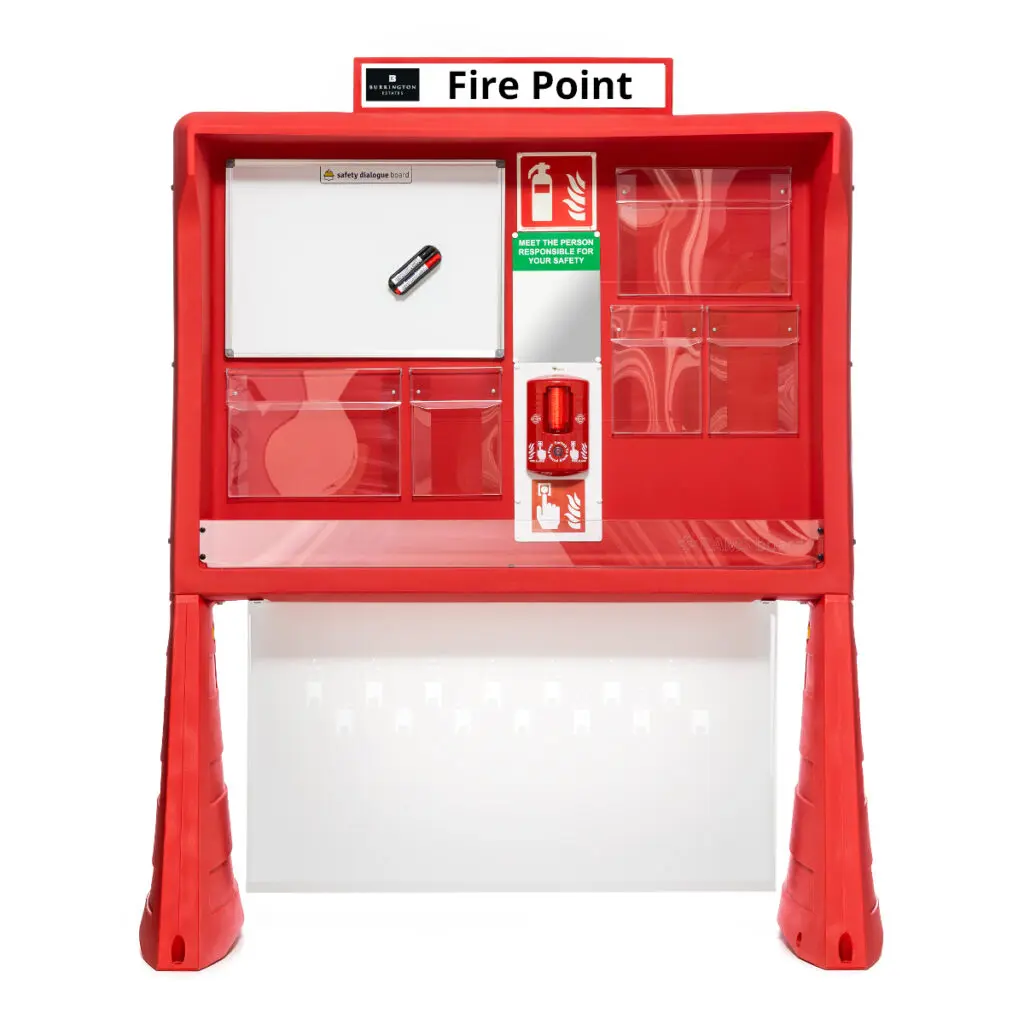
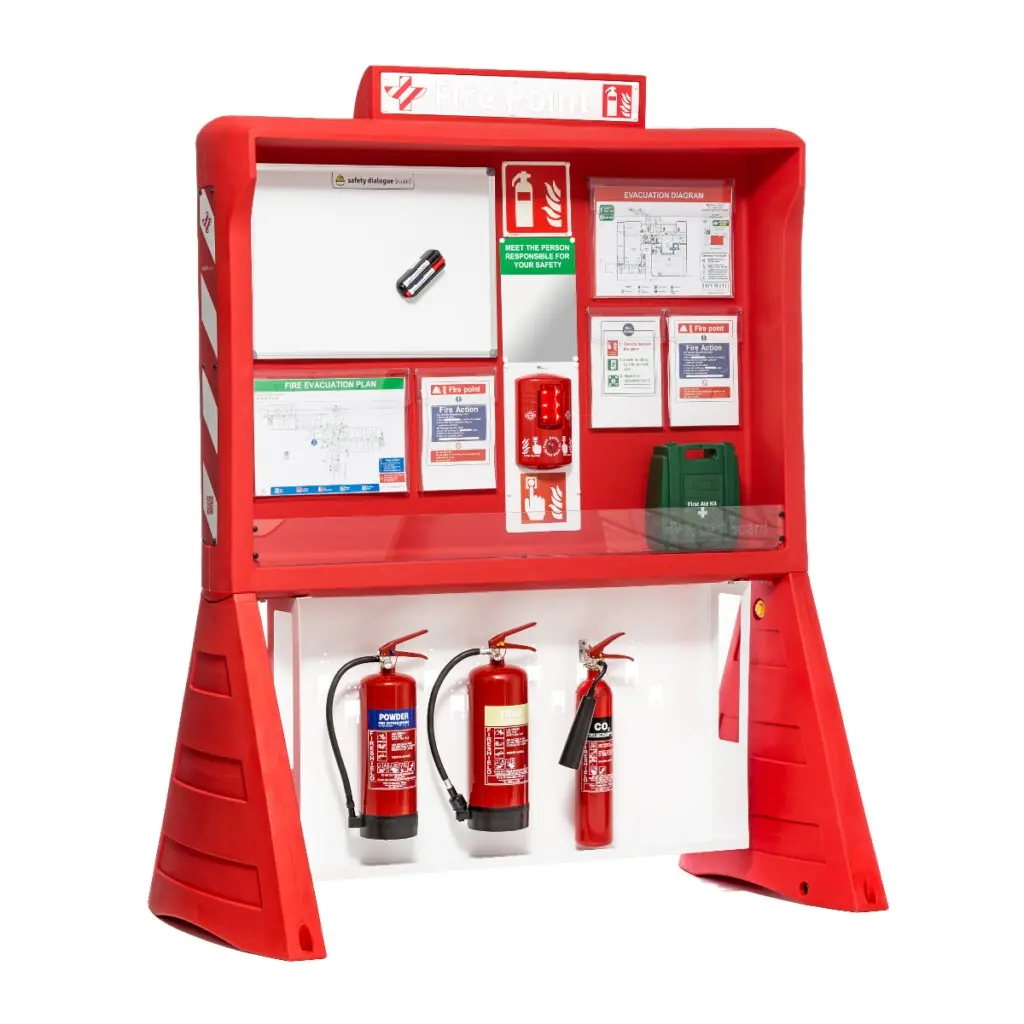
Equally crucial are directional exit signs, which provide clear guidance to emergency exits during critical situations. These signs streamline evacuations, ensuring employees and visitors can quickly and safely find their way out.
- Enhanced Emergency Preparedness: Directional signs ensure clear and unmistakable guidance during evacuations.
- Strategic Placement: Thoughtfully positioning these signs near health and safety information points enhances their effectiveness.
By pairing fire extinguisher bundles and directional exit signs with health and safety information points, organizations can transform emergency response. This creates a workplace where safety isn’t just a priority—it’s a way of life.
Choosing the right free-standing Health & Safety Information Point
Workplace safety isn’t just important—it’s essential. Selecting the ideal free-standing health and safety information point is a decision that carries significant weight. These units play a pivotal role in delivering vital messages that keep everyone informed and secure. By carefully assessing your workplace’s specific needs, you can choose an information point that seamlessly integrates into your environment, fostering a culture where safety becomes second nature, not just a policy.
Factors to consider: location, purpose, and customization
When selecting the right safety information point, three key factors should guide your decision:
- Location: The unit should be placed in a highly visible and accessible spot. High-traffic areas such as entrances, break rooms, or other communal spaces are ideal to ensure maximum visibility.
- Purpose: Define the role of the information point. Will it outline emergency procedures, emphasize PPE requirements, or detail site-specific safety protocols? Its function must align with the unique demands of your workplace.
- Customization: Incorporate your company’s branding or tailored safety messages. This makes the unit more relevant and engaging, helping employees connect with the information on a deeper level.
Leading Suppliers: Safety Buyer UK Ltd. and Seton UK
Where can you find these essential tools? Two standout suppliers are Safety Buyer UK Ltd. and Seton UK. Both companies offer a wide range of products designed to elevate workplace safety standards:
| Supplier | Key Offerings | Mission |
|---|---|---|
| Safety Buyer UK Ltd. | Free-standing health and safety information points and other workplace safety products | To provide robust solutions that enhance workplace safety |
| Seton UK | Compliance posters, customizable information points, and a wide range of safety solutions | To help businesses stay compliant while prioritizing team safety |
Partnering with these trusted suppliers is more than just meeting regulations—it’s a statement of your commitment to creating a safer, more informed workplace.
As workplace safety standards continue to evolve, it’s worth considering how these suppliers will adapt. The future of safety information points is bound to be both dynamic and impactful, with innovations that meet the shifting needs of modern businesses.
Future trends in Free-Standing Health & Safety Information Points
Workplace safety is undergoing a rapid transformation, and the future of free-standing health and safety information points is set to be revolutionary. A key development is the integration of safety compliance posters with cutting-edge design and advanced functionality. This evolution goes beyond aesthetics—it focuses on creating practical, intuitive solutions that meet the dynamic needs of modern workplaces.
In the years ahead, these information points are expected to feature ergonomic enhancements such as anti-fatigue mats and height-adjustable workstations. These additions aim to reduce the physical strain on employees who spend long hours standing on the job. By prioritizing worker comfort, these tools not only promote physical well-being but also boost morale, efficiency, and job satisfaction. As organizations increasingly emphasize safer and more productive environments, the role of thoughtful, user-centric design in safety equipment will become even more critical.
Innovations in design and functionality
The evolution of free-standing health and safety information points is characterized by a focus on ergonomic design and user-friendly features. For example, anti-fatigue mats are no longer just simple floor coverings—they are engineered to alleviate fatigue and discomfort for employees who stand for extended periods. By providing cushioning and support, these mats help reduce pressure on the feet and legs, making the workday more manageable and productive.
Another groundbreaking innovation is the introduction of adjustable workstations. These workstations can be tailored to an individual’s height and specific job requirements, promoting better posture and reducing the risk of physical strain. By enabling workers to customize their workspaces, companies can create a more inclusive and adaptable environment. These advancements are redefining the intersection of safety, comfort, and workplace design, setting new standards for employee well-being.
The role of technology in enhancing workplace safety
Technology is playing a pivotal role in transforming free-standing health and safety information points, reshaping how businesses approach workplace safety. One major breakthrough is in the area of tracking and reporting safety compliance. Digital tools now enable these information points to gather and analyze data in real time, simplifying adherence to safety regulations.
Additionally, advanced features such as digital displays and sensors can monitor environmental conditions like air quality and noise levels, offering critical insights into potential hazards. Mobile apps and cloud-based platforms further enhance safety by streamlining the sharing of updates and alerts, ensuring that employees stay informed and aligned with the latest protocols.
As technological innovations continue to evolve, the potential for improving workplace safety is limitless. The future may lie in seamlessly integrating digital advancements with proven safety practices—a compelling vision that could foster a more adaptive and proactive safety culture.
Conclusion: creating a safer workplace with Free-Standing Information Points
Building a safer workplace is not a one-time task—it’s a continuous journey. One highly effective way to enhance your safety standards is by incorporating free-standing information points. Think of these as dedicated safety hubs where critical messages are not only visible but also impossible to ignore. When strategically placed, they go beyond merely sharing information—they help cultivate a culture where safety becomes second nature, ensuring that essential details are always within easy reach.
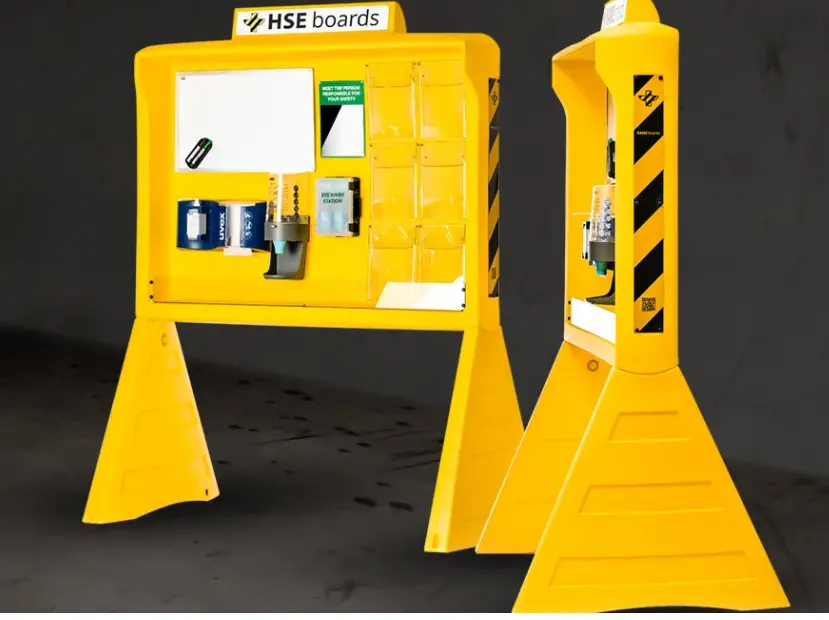
At the heart of this approach is clear and effective communication. These free-standing stations act as specialized bulletin boards, exclusively designed for safety essentials. They provide a centralized location for vital information, such as:
- Emergency protocols to guide employees during critical situations.
- PPE (Personal Protective Equipment) guidelines to ensure proper usage and compliance.
- Site-specific rules tailored to your workplace environment.
By prominently positioning these stations, they become hard to overlook, significantly reducing the risk of accidents and ensuring that everyone remains informed, aligned, and aware.
What makes these information points even more impactful is their customizability. They are far from a one-size-fits-all solution. You can tailor them to meet the unique demands of your workplace by:
- Adapting the content to reflect your organization’s specific safety priorities.
- Incorporating branding elements to reinforce your company’s identity.
- Designing them to engage employees and encourage compliance.
This personalized approach not only makes the information more relevant but also enhances employee engagement and adherence to safety protocols. As workplaces continue to evolve and face new safety challenges, one thing remains clear: free-standing information points are adaptable and ready to meet these demands. The real question is, are you ready to embrace this next step in workplace safety?
